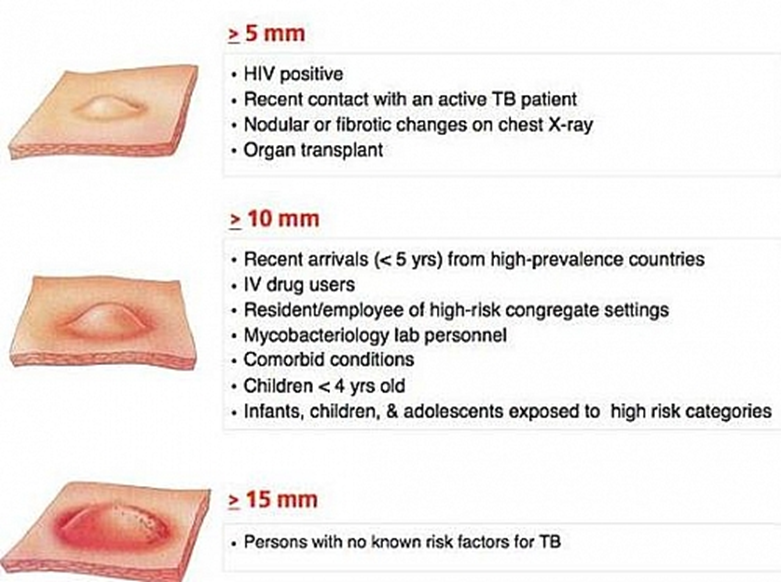Which nursing assessment indicates a positive reading of a tuberculin (TB) skin test?
1 day after injection with a 10-mm area of redness and swelling
2 days after injection with a 5-mm area of redness and swelling
4 days after injection with a 3-mm area of redness and swelling
5 days after injection with a 2-mm area of redness and swelling
The Correct Answer is A
A. 1 day after injection with a 10-mm area of redness and swelling:
This may suggest a positive reading, but induration size is the primary criterion for interpretation, not just redness and swelling.
B. 2 days after injection with a 5-mm area of redness and swelling:
Similar to option A, a 5-mm area of redness and swelling alone does not definitively indicate a positive TB skin test. Again, without information on the size of the induration, we cannot determine if this reading is positive.
C. 4 days after injection with a 3-mm area of redness and swelling:
Once more, a 3-mm area of redness and swelling alone does not definitively indicate a positive TB skin test. As with the previous options, the size of the induration is the critical factor for interpretation.
D. 5 days after injection with a 2-mm area of redness and swelling:
As with the other options, a 2-mm area of redness and swelling alone does not definitively indicate a positive TB skin test. The presence and size of induration are essential for accurate interpretation.

Nursing Test Bank
Naxlex Comprehensive Predictor Exams
Related Questions
Correct Answer is A
Explanation
A. Encourage the client to drink 8 glasses of water a day.
This is the correct choice. Clients with COPD often have thickened respiratory secretions due to chronic inflammation and mucus production. Adequate hydration helps to keep these secretions thin, making them easier to cough up and clear from the airways. Encouraging the client to drink plenty of fluids, such as water, can assist in maintaining optimal hydration levels and promoting effective airway clearance.
B. Instruct the client to cough every 4 hours.
Instructing the client to cough on a scheduled basis, such as every 4 hours, is not appropriate for managing COPD. While coughing is important for clearing respiratory secretions, the frequency of coughing should be based on the client's individual needs and symptoms. Some clients with COPD may need to cough more frequently, while others may need to cough less often. It's important to encourage the client to cough as needed to clear secretions rather than on a predetermined schedule.
C. Provide the client with a low-protein diet.
Providing the client with a low-protein diet is not recommended for managing COPD. Adequate protein intake is important for maintaining muscle strength, including respiratory muscles, and supporting overall health. Clients with COPD may have increased energy needs due to the increased work of breathing and should be encouraged to consume a balanced diet that includes adequate protein.
D. Advise the client to lie down after eating.
Advising the client to lie down after eating is not recommended for managing COPD. Lying down after eating can increase pressure on the diaphragm and make breathing more difficult, especially for individuals with compromised lung function. It's generally recommended for individuals with COPD to remain in an upright position after eating to minimize respiratory discomfort and reduce the risk of aspiration.
Correct Answer is A
Explanation
A. Expiratory wheeze
Expiratory wheeze is a high-pitched, musical sound heard primarily during expiration. It occurs when air passes through narrowed airways due to bronchoconstriction, inflammation, and increased mucus production, which are characteristic features of an acute asthma exacerbation. Expiratory wheezes are commonly heard upon auscultation of the chest in individuals experiencing asthma exacerbations.
B. Pleural friction rub
Pleural friction rub is a dry, crackling or grating sound heard during both inspiration and expiration. It typically occurs when the inflamed pleural surfaces rub against each other during breathing. Pleural friction rub is associated with conditions such as pleurisy (inflammation of the pleura) or pleural effusion (accumulation of fluid in the pleural space), rather than asthma exacerbations.
C. Fine rales
Fine rales, also known as fine crackles, are brief, high-pitched, discontinuous sounds heard primarily during inspiration. They are typically associated with conditions involving the small airways and alveoli, such as pulmonary fibrosis or congestive heart failure. Fine rales are not commonly heard in asthma exacerbations.
D. Rhonchi
Rhonchi are low-pitched, snoring or rattling sounds heard primarily during expiration. They result from the passage of air through airways obstructed by thick mucus or secretions. While rhonchi may be heard in individuals experiencing asthma exacerbations, they are less characteristic than expiratory wheezes, which are more commonly associated with asthma exacerbations. Rhonchi are often associated with conditions such as chronic bronchitis or pneumonia.
Whether you are a student looking to ace your exams or a practicing nurse seeking to enhance your expertise , our nursing education contents will empower you with the confidence and competence to make a difference in the lives of patients and become a respected leader in the healthcare field.
Visit Naxlex, invest in your future and unlock endless possibilities with our unparalleled nursing education contents today
Report Wrong Answer on the Current Question
Do you disagree with the answer? If yes, what is your expected answer? Explain.
Kindly be descriptive with the issue you are facing.
